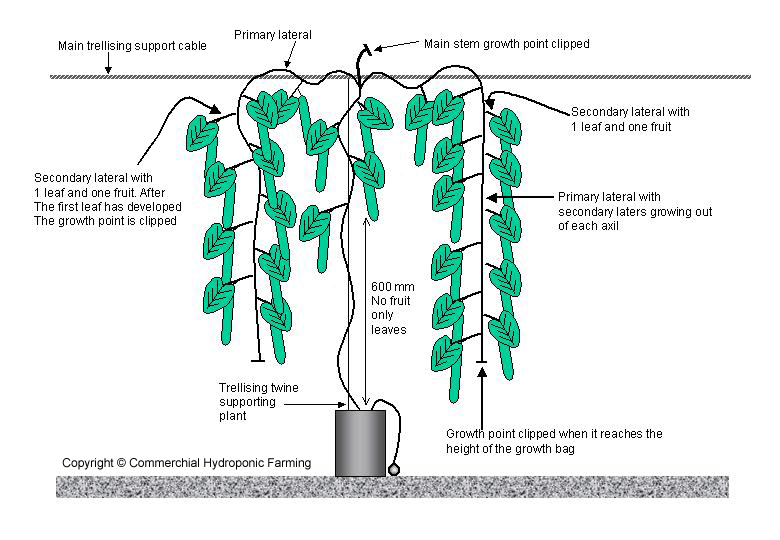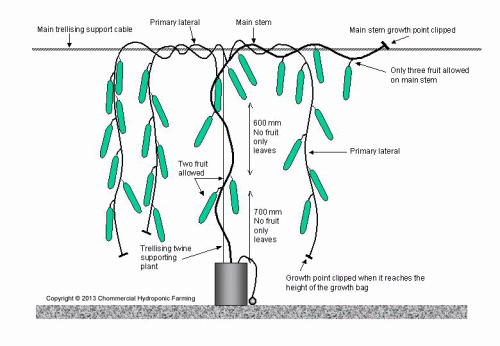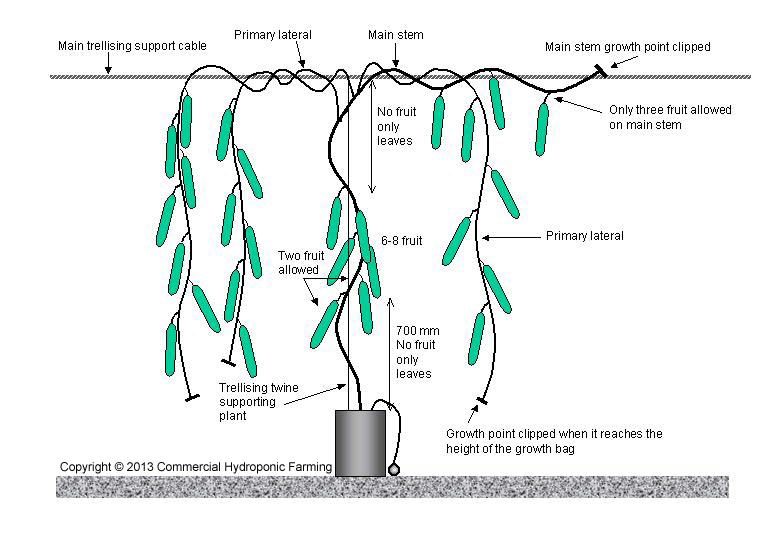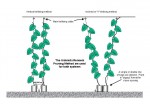Pruning cucumbers in greenhouses
Selecting a cucumber pruning system
The question arises which system should be used. Each system has its advantages and disadvantages according to the ability and managerial skill of the grower, the experience of his labour, capital available to build the various structures, climatic conditions of the area etc. The easiest to apply are the vertical training systems using the URS pruning method. Other systems such as the Inclined Training System (ITS) and Guernsey Arch Method (GAM) need skilled labour to establish but requires less maintenance once the plants have grown over the arch. These systems allow for easy picking and identifying the fruit. However, they do require large amounts of good light in order to produce good quality fruit.
Pruning cucumbers
Pruning cucumbers is essential for optimum growth and quality of fruit. However, they should not be pruned as prudently as tomatoes. The amount of leaves that should be removed is comparable with peppers and brinjals.
Cucumber yield can be correlated with total leaf area. The more leaves are left on the plant the more the plant can photosynthesise and more energy there is for fruit production. The only time when pruning cucumbers is essential is when leaves are damaged due to movement in the aisles and disease or insect damage. Some leaves are also removed to improve ventilation between crops. Never remove leaves in the same way as in a tomato crop. Never remove more than one leaf at a time. By removing more the plant can go in a state of shock and abort fruit, drop flowers and produce crooked fruit.
Initially the crop is only allowed to grow one stem. This implies removing all side shoots developing as explained under the sections in tomatoes and peppers.
Pruning cucumbers also involves the removal of fruit. This is probably one of the most neglected activities. It is easy to understand why, no grower likes to through money away and if advised to remove some fruit, the grower assumes you are crazy or they are perpetual optimists and think that one fruit will not make a difference. One fruit can make a difference, that is the problem and that is how sensitive cucumbers are. There should be a fine balance between fruit load and growth. If this balance can be kept optimally, high yields will be achieved. Not only will the yields be high, but the percentage of marketable fruit will also be high, and the percentage class 1 fruit will be higher. A plant that is overworked (or overgrown) can never regain lost vigour, not even with additional nutrients or foliar feeding. The following aspects are important to remember when pruning cucumbers:
- There should never be more than one fruit per axil
- Prune, train and trellis the plant at least once a week
- Rather remove fruit at the top than leave to many on the plant
- Remove crooked fruit as early as possible
- Learn to read a plant; know when it is overworked or under worked
Cucumbers are extremely fast growing plants especially under favourable conditions such as in well ventilated greenhouses. Many growers, especially inexperienced growers have been caught out by the speed the plant grows and the amount of effort needed to control the plant growth through the various pruning and trellising activities. Just as tomatoes, peppers and brinjals, cucumbers have to be pruned in a specific way. Proper pruning methods have the following advantages:
- Increases yield per square meter
- Reduces number of crooked fruit
- Reduces the risk of disease development
- Allows for higher plant densities
- Easier picking
- Mature fruit are easy to spot
There are three basic methods that can be used when pruning cucumbers. They are:
- The high training system
- The umbrella renewal system and
- Low middle training system
Each plant is trained by intertwining the main stem with a vertical piece of twine (trellising twine) suspended from a horizontal support cable or wire at least 2.2 m high. Some growers prefer to place the main support wire at least 2.8 to 3.0 m high. At these heights a trellising methods is not used. The plants are simply allowed to grow straight up and when they reach the top the growth points are clipped. The plant is left until the last fruit is harvested after which it is removed and replaced.
The High Pruning system (HPS)
The high Pruning system is not that common with modern greenhouses but a brief explanation of how it works is important for a comparison of other systems. This system is used when the greenhouse are very low, at least 2 m up to the gutter of the tunnel. To prune cucumbers in the High Pruning System use the following steps:
- Let the plant wind up the central trellising twine.
- Remove all fruit from the top of the bag for 700 mm.
- Leave two fruit and remove all fruit for the next 600 mm
- Leave one fruit per axil up to the main trellising wire
- Lead the main stem to wind round the main trellising wire for at least 300 mm and allow a maximum of 3-4 fruit depending on plant vigour
- Clip the growth point of the main stem as it reaches 300 mm
- Allow three side shoots to grow. One should grow in the direction of the main growth point and the other two in the opposite direction
- Allow the first side shoot to grow 200 mm along the main stem and let it grow to the ground allowing one fruit for every two axils
- The other two shoots should be grown 150-200 mm and 300 mm respectively in the opposite direction of the main stem.
- Wind the side shoots around the main trellising wire.
- At recommended distances let the side shoot grow to the ground allowing one fruit for every two axils.
- As soon as the tips of the growth points reach the height of the bags the growth points should be clipped and all other side shorts removed.
- When the last mature fruit is harvested remove the plant and replace with a new one.
The basic principles as explained earlier must apply. Always monitor the plant during growth. If the plant shows any stress signs one must react immediately by removing either more fruit, spraying or changing the fertilizer program. Remember to remove crooked fruit early enough as well as damaged fruit. Allow only three side shoots to grow, not more as this will drain the plant from energy to produce fruit and grow the remaining side shoots.
The Umbrella Renewal System (URS)
The Umbrella Renewal System (URS) or also known as the Modified Umbrella System (MUS), is used commonly in modern greenhouses where the main trellising wire is high, at least 3 m. The following steps should be followed to train the plant in the ORS system:
- Let the plant wind up the central trellising twine.
- Remove all fruit from the top of the bag for 700 mm.
- Allow a fruit in each axil up to the main trellising cable.
- At the main cable clip the main growth point and allow two side shoots to grow in opposite directions along the main trellising cable. The side shoots should be winded around the main trellising cable.
- Allow two laterals to grow out of the side shoots growing along the main trellising cable
- No fruit should allowed to grow along the trellising cable.
- There should be six laterals growing down from the main trellising cable to the ground.
- As soon as the tips of the side shoots reach the height of the growth bag the growth point is clipped.
- A fruit is allowed to grow in each axil but the plant should be monitored. If it starts losing its vigour or produces large amounts of crooked fruit, only one fruit per two axils should be allowed.
- Once the laterals have reached the height of the growth bag and the plant has enough vigour, new shoots are allowed to grow from the main trellising cable. However the vigour of the plant will depend on climate and management.
The original Umbrella Pruning System was extremely complicated. It is in principle the same as the URS system but the laterals that grow out from the main stem on the trellising wire are allowed to grow one leaf and a fruit. After the first leaf of the lateral the growth point is clipped. Thus you have instead of just a fruit growing out of the plant, a lateral with a leaf and a fruit. The laterals that grow down from the main stem have a lateral growing out of the stem with two fruit. This method is extremely complicated to maintain and that is also the reason why it was abandoned and the Modified Umbrella System or Umbrella Renewal System was developed instead.

The Umbrella Renewal System (URS) or also known as the Modified Umbrella System (MUS), is used commonly in modern greenhouses where the main trellising wire is high, at least 3 m
Low-Middle Pruning System (LMPS)
The Low Middle Pruning System (LMPS) is a combination of the URS and HPS system except for the following:
- Remove all fruit for the first 700 mm
- Only eight fruit is allowed to grow on the main stem with a fruit in each axil
- After the eighth fruit all other fruit are removed
- The main stem and its side shoots are allowed to grow along the main trellising wire just as in the HTS system described earlier






Hi there, Great tips by the way and thank you. I did
have a question though. I’m hoping you can answer it for me since
you seem to be pretty knowledgeable about gardening. How do shovel headed garden worms help in your
garden? If you had some insight I would greatly appreciate it.
Contrary to what many people think, earth worms can do harm in a garden. They tend to break down the structure of the soil which reduces aeration and permeability. Obviously this will depend on the number of earthworms you have in the garden. Since Hammer head or Shovel head worms feed on earthworms there is a natural balance. So in that sense I would say they are beneficial. My daughter has a different opinion of them at night though.
Dear Antonius,
I have gone through your article with great interest. I got involved with scientist practicing and removing toxic metals to produce clean water during my period in Germany. I am trying to reverse the process by inoculating raw water with nutrients required by Cucumber plants. I am in the process of establishing a 400 m2 poly house farm using Nutrient Film technology in deep water culture. If feasible I would like very much to get your views on our farm coming up in central Kerala, India. If you have the time, kindly let me have your mail address to enable me to mail you details of our project.
with best wishes,
p.vaudevan + 91 9447521017
Hi. Yes we have done some work with pollutants but cucumbers are very sensitive to chemicals. It might be better to use hardy plants first to remove all the heavy metals before using commercial crops. Nobody wants to eat cucumbers with very high levels of heavy metals.